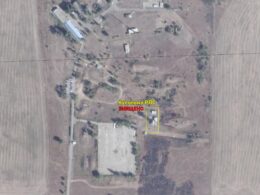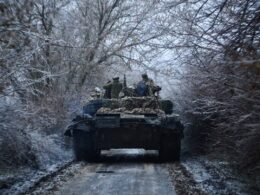Russia’s aim is to create a pro-Kremlin information space in the occupied regions to erode Ukrainian national identity. The first merchant ship successfully crosses the Ukrainian sea corridor, sidestepping Russia. The US, Europe are working to ensure that Ukrainian pilots start training on F-16 jets “as soon as possible.”
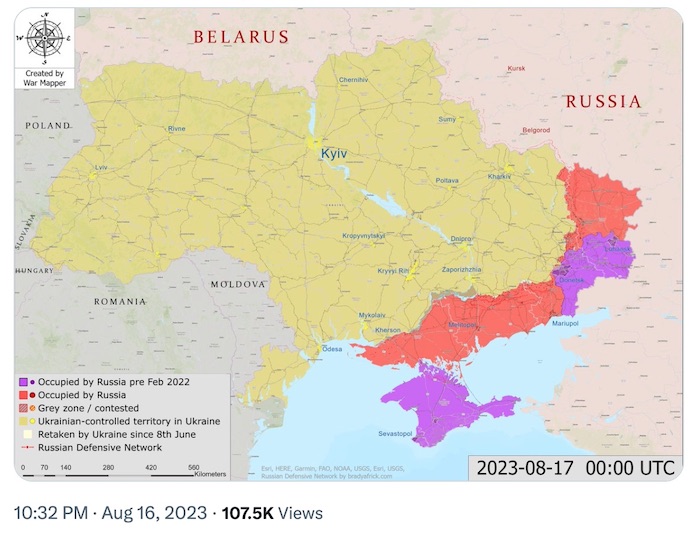
Daily overview — Summary report, August 18

According to information from the General Staff as of 06.00 18.08.2023, supplemented by its [18:00 assessment].

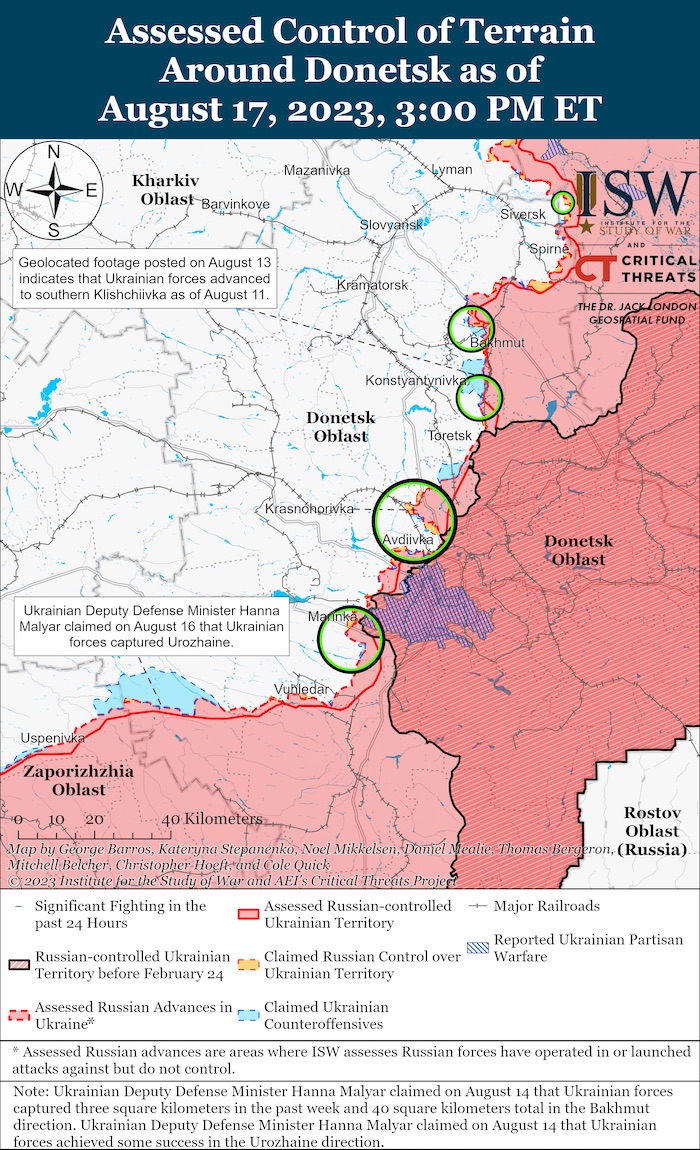
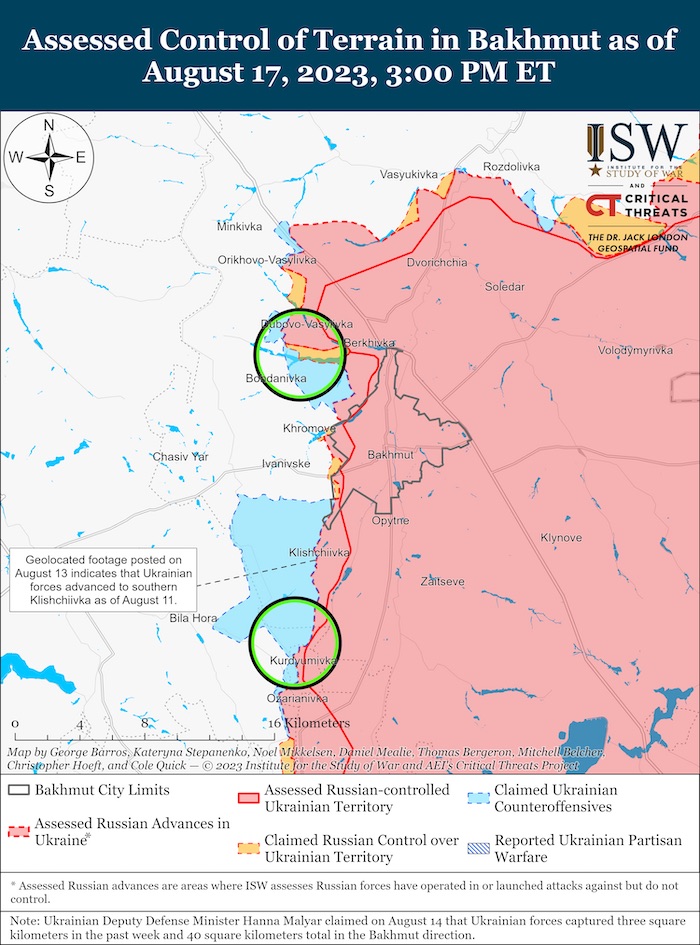


Military Updates

Kirby says US, Europe are working to ensure that Ukrainian pilots start training on F-16 jets “as soon as possible”. The United States and Europe are working to ensure that Ukrainian pilots start training on F-16 fighter jets “as soon as possible,” said John Kirby, the US National Security Council Coordinator for Strategic Communications. At the same time, he added that he had no new information related to the Ukrainian pilot’s training.
General Staff: Ukrainian Forces consolidate gains further south from the recently liberated Urozhayne. Ukraine’s defense forces are advancing in three areas, have secured territory south of the important town of Urozhayne. A military spokesman marking continued momentum in Ukraine’s counteroffensive.
According to British Defence Intelligence, (last 48 hours):

- On 15 August 2023, First Deputy Head of the Russian Presidential Administration Sergey Kiriyenko travelled to Donetsk in Russian-occupied eastern Ukraine to visit schools and check their integration into the Russian education system.
- Journalists from Russia are also being employed in media outlets in the occupied regions. A new textbook on the history of Russia will be issued to schools in the occupied regions of Ukraine and throughout the Russian Federation from 1 September 2023. The book praises the so-called special military operation and describes Ukraine as an ultra-terrorist state.
- Russia’s aim is to create a pro-Kremlin information space in the occupied regions in order to erode Ukrainian national identity.
Losses of the Russian army
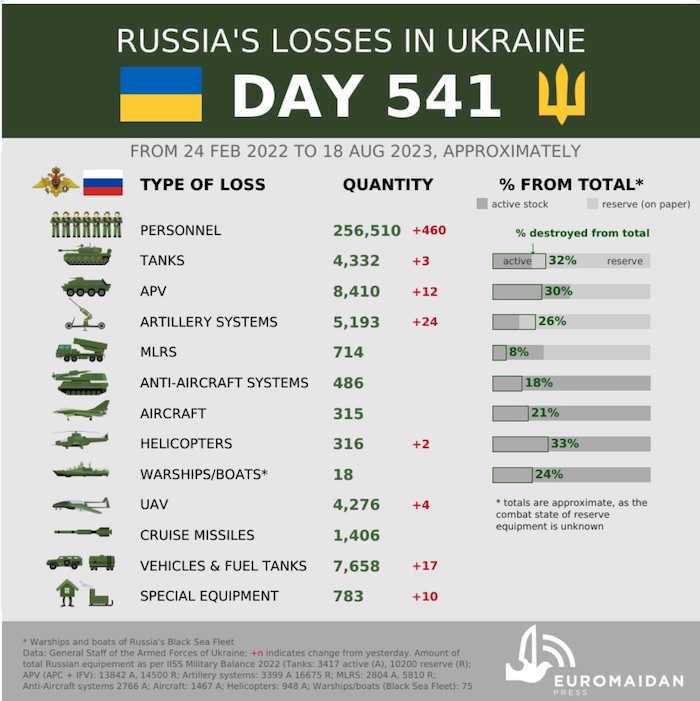
Humanitarian
Ukraine gov’t: over 20,000 Russia-mobilized Horlivka residents died in all-out war. More than 20,000 residents of Russian occupied Horlivka mobilized to fight against Ukraine have been killed in actions since the beginning of Russia’s full-scale invasion, according to the Ukrainian Government’s data.
“We will kill them all”: Why Russia’s war against Ukraine is genocide. This report summarizes several lectures during the past year by Timothy Snyder, Yale University Richard C. Levin Professor of History and permanent fellow at the Institute for Human Sciences in Vienna, in which he provides definitive facts about why Russia’s war is a Ukrainian genocide. Snyder is the author of many books, including “Bloodlands: Europe Between Hitler and Stalin,” published in 2010.
Ukraine builds up fuel reserves, braces for challenging winter ahead. Ukraine demonstrated last winter that its skilled energy workforce could maintain the power grid. Despite ongoing Russian attacks, Ukraine has successfully mobilized its mining sector and amassed substantial gas reserves to withstand the winter, the British intelligence writes in its daily update: “Despite the consistent pressures of war, Ukrainian efforts to build up fuel stockpiles will likely be successful in ensuring that it will have sufficient fuel reserves during the approaching winter period.
Environmental
First merchant ship successfully crosses Ukrainian sea corridor, sidestepping Russia. On 16 August 2023, the first civilian cargo ship left the Ukrainian seaport of Odesa and, despite Russian threats, successfully reached the territorial waters of Bulgaria and then Romania using mostly Ukrainian territorial waters.
Support
Czechia plans to supply Ukraine with Mi-24 combat helicopters, defense minister says. Prague plans to send Mi-24 combat helicopters to Ukraine, Czech Minister of Defence Jana Černochová has announced, according to CeskaTelevize. According to the minister, Czechia will soon receive new helicopters from the US, while the old Soviet-made Mi-24 helicopters will be transferred to the Ukrainian Army.
New Developments
Stoltenberg downplays idea Ukraine could give up land for membership – The Guardian. NATO’s Secretary General Jens Stoltenberg has said it is up to Ukraine to decide when and under what conditions to begin any negotiations on ending the war with Russia after comments of a key aide about a land-for-NATO-membership agreement, according to The Guardian.
Fire breaks out at ice arena in Russia’s Yekaterinburg. On 17 August, a fire broke out in Russia’s city of Yekaterinburg, located over 2000 km from Ukraine. The blaze originated at a construction site of an ice arena in the city center, as per the Kremlin-aligned media RIA Novosti. “The UGMK Rink, which is under construction, has caught fire in Yekaterinburg, the Emergency Ministry reports,” the news report said.
Ukraine expects over 30,000 Uman pilgrims for Rosh Hashanah in 2023. Over 30,000 Hasidic Jew pilgrims plan to visit the city of Uman in fall 2023 to mark Rosh Hashanah, says Ukraine’s State Service for Ethnic Affairs and Freedom of Conscience. Thousands of Israeli pilgrims visit the city of Cherkasy Oblast each year to pray at the gravesite of Rebbe Nachman of Breslov. However, Ukraine has warned that visiting Uman amid the war is dangerous.
NATO strategist’s Ukraine “land grab” slip is as absurd as revealing. A NATO strategist prompted Ukrainian fury and NATO backpedaling after arguing Ukraine could trade territory for NATO membership, a slip that reveals how much the Alliance is willing to play along with Russian aggression.
Assessment
- On the War
The Institute of Study of War has made the following assessment as of 17 August:
“Vostok” Battalion commander Alexander Khodakovsky suggested that Russia freeze the war in Ukraine along the current frontlines, reintroducing a narrative that had been largely dormant since Wagner Group financier Yevgeny Prigozhin’s armed rebellion. Khodakovsky stated that Russia will not be able to topple Ukraine militarily in the near term and that Russian forces are unlikely to easily occupy additional Ukrainian cities, echoing comments Prigozhin had made in April 2023.[1] Khodakovsky concluded that Russia will likely have to come to a “truce” and that Russia may enter a phase “of neither peace nor war” with Ukraine.[2] Khodakovsky suggested that Ukraine would be sufficiently weakened in this state of frozen conflict and that Russia would be able to exert more influence over Ukraine in such a situation than it currently can during the ”Special Military Operation.”[3] Prigozhin’s April 14 essay suggested that Russia freeze the war in Ukraine to set conditions for a future victory without negotiations.[4] Russian sources have periodically claimed that a Kremlin faction is interested in freezing the war along the current frontlines for similar reasons as well as over concerns about domestic political stability and the economic fallout from the war.[5] Discussion of this narrative has waned with Prigozhin’s relative silence following Wagner’s June 24 rebellion and the arrest of ardent ultranationalist Igor Girkin, who routinely called on the Kremlin to resist the faction that aims to freeze the war.[6] Khodakovsky may be reintroducing the narrative into the Russian information space on behalf of the faction allegedly interested in freezing the war, although Khodakovsky likely has limited influence on the Russian leadership itself. ISW continues to assess that a temporary ceasefire in Ukraine and protraction of the war will only benefit Russia by allowing Russian forces to reconstitute and letting Russia wear down Western support for Ukraine.[7]
Khodakovsky commands forces defending in the Donetsk-Zaporizhzhia Oblast border area and his comments about freezing the war follow the Ukrainian liberation of Urozhaine on August 16, suggesting that recent Ukrainian advances may be significantly weakening confidence in the Russian defense along the wider front in southern Ukraine. Khodakovsky has previously highlighted concerns about the Russian defense in the Donetsk-Zaporizhzhia Oblast border area, specifically relating to poor Russian counterbattery capabilities, heavy Russian losses, exhausted Russian forces, and a lack of reserves.[8] Khodakovsky previously called for an operational pause on August 13 so that Russian forces could accumulate resources for a new operation.[9] Khodakovsky’s escalation from calling for an operational pause to suggesting that Russia freeze the conflict is likely associated with his firsthand experience of recent tactically significant Ukrainian advances and the degradation of defending Russian forces in Urozhaine.
Recent Ukrainian advances near small settlements in the Donetsk-Zaporizhzhia Oblast border area and in western Zaporizhzhia Oblast are likely tactically significant because of the structure of Russian defensive lines. Ukrainian Colonel Petro Chernyk stated on August 15 that the three-echeloned Russian defensive line in southern Ukraine is comprised of a first line of minefields stretching several kilometers deep; a second line with artillery, equipment, and personnel concentrations; and a third line of rear positions meant to preserve resources.[10] Recent Ukrainian advances north and northeast of Robotyne (10km south of Orikhiv) in western Zaporizhzhia may allow Ukrainian forces to begin operating in the areas past the densest minefields.[11] If the areas around the second Russian line of defense are less heavily mined, then they would likely be more conducive to more rapid Ukrainian gains. ISW has no ability to assess the density or depth of Russian minefields, however.
Russian forces have dedicated significant effort, resources, and personnel to hold settlements such as Robotyne and Urozhaine, and recent Ukrainian advances in these areas are therefore likely reflective of a wider degradation of defending Russian forces. ISW continues to assess that Russian forces lack significant operational reserves, and the intense Russian effort to hold these settlements instead of withdrawing their forces means that Ukrainian forces have likely had to thoroughly degrade Russian units before advancing.[12] ISW recently observed Russian forces conduct lateral redeployments of elements of the 7th Guards Airborne (VDV) Division from Kherson Oblast and possibly from the Donetsk-Zaporizhzhia Oblast border area to the Robotyne area, further suggesting that recent Ukrainian advances have significantly degraded the Russian forces that have been defending in western Zaporizhzhia Oblast without rotation since the start of the counteroffensive.[13] The lack of Russian operational reserves means that Russian forces will have to reinforce certain areas of the front at the expense of others, likely weakening Russian defensive lines in aggregate and offering Ukrainian forces opportunities for exploitation.[14] Khodakovsky’s recent complaint that the Russian command failed to send reinforcements to secure exhausted Russian forces defending Urozhaine may indicate that the Russian command is already making difficult choices about what sectors to prioritize as Ukrainian forces advance.[15] Russian forces increasingly appear likely to have to withdraw to secondary prepared defensive positions without significant support in the case of a Ukrainian breakthrough, and the further degradation of Russian forces creates opportunities for any Ukrainian breakthrough to be potentially operationally significant.[16] Khodakovsky’s apparent waning confidence in the Russian defense in southern Ukraine may indicate that he believes that recent advances have made a Ukrainian breakthrough more likely.
Ukrainian forces continued counteroffensive operations on at least three sectors of the front on August 17 and advanced near Bakhmut and in western Zaporizhzhia Oblast. The Ukrainian General Staff reported that Ukrainian forces continued offensive operations in the Bakhmut, Berdiansk (Donetsk-Zaporizhzhia Oblast border area), and Melitopol (western Zaporizhzhia Oblast) directions.[17] Geolocated footage published on August 16 indicates that Ukrainian forces made marginal gains in southern Klishchiivka (7km southwest of Bakhmut).[18] Additional geolocated footage published on August 14 indicates that Ukrainian forces advanced southwest of Novopokrovka (16km southeast of Orikhiv).[19] The Ukrainian General Staff reported that Ukrainian forces shot down two Russian Ka-52 attack helicopters on August 17.[20] Ukrainian military sources and geolocated footage posted on August 17 indicate that Ukrainian forces downed a Russian Ka-52 helicopter near Robotyne in western Zaporizhzhia Oblast.[21] Ukrainian Air Force Commander Mykola Oleshchuk stated that Ukrainian air defense units downed another Russian Ka-52 helicopter in the Bakhmut direction, although ISW has not observed visual confirmation of a downed Russian Ka-52 helicopter in this direction.[22] The destruction of two Russian Ka-52 helicopters in the same day could indicate that protracted Russian aviation operations without rest may be degrading Russia’s limited cadre of pilots, although it would be premature to draw firm conclusions from two instances.
Russian efforts to ramp up the domestic production of Iranian Shahed-136/-131 drones indicate that Russia aims to develop the long-term capability to conduct large strike series in Ukraine. The Washington Post reported that a drone production facility in the Alabuga Special Economic Zone aims to build 6,000 Iranian Shahed drones domestically by 2025.[23] The Washington Post cited leaked documents from a disillusioned Alabuga facility worker that state that Russia aims to develop a drone manufacturing capability that exceeds Iran’s production capacity and aims to improve on existing capabilities of the Iranian Shahed-131 and -136 drones. The report noted that Russia is focused on producing and improving the Shahed-136 variant, which has a payload 10 times larger than the Shahed-131. Ukrainian Air Force Spokesperson Yuri Ihnat stated on August 17 that Russian forces are producing many missiles, helicopters, and aircraft but are unable to sustain this production.[24] Ihnat recently assessed that Russian forces will rely on strike drones because they are cheaper and easier to manufacture than precision missiles.[25] Ihnat stated that Russian forces are largely launching precision missiles that Russia recently produced, which indicates that Russian forces are prioritizing targeting Ukraine with precision missiles over restoring their stockpiles.[26] Russian forces currently use Shahed drones in Ukraine primarily as decoys so that high precision missiles have better chances of hitting their targets. The Russian command may believe that a large number of strike drones will allow Russian forces to overwhelm Ukrainian air defenses, although Shahed drones remain Russia’s high precision weapon system most vulnerable to Ukrainian air defenses.[27] Shahed drones do not carry sufficient payloads to significantly damage most critical military targets, and Russian forces are likely to continue using the drones to target soft and civilian targets in Ukraine.[28]
The Washington Post report indicates that Russia is struggling to produce its own variants of the Shahed drones at the pace and quality it desires. The Washington Post cited experts who assessed from the leaked documents that the Alabuga drone production facility has only manufactured the external components for 300 drones and is about one month behind schedule.[29] The leaked documents indicate that the Alabuga facility has struggled to fill specialist positions and that workers, including the one who leaked the documents, struggle with morale issues and that the plant has had to implement incentives such as increased pay and coercive measures such as seizing passports to retain workers. The documents also indicate that the Alabuga facility is struggling to obtain necessary drone components from foreign sources, as Russia only produces four of the 130 necessary internal components, and recent US blanket sanctions have further hindered Russia’s ability to acquire some electrical components.
Russia is likely dissatisfied with the quality of Shahed-131- and -136 drones it sources from Iran but likely seeks to retain Iran as a long-term strategic defense partner. The Washington Post’s leaked documents indicate that Iran has consistently held an advantage over Russia with the provision of the Shahed drones on Iranian rather than Russian terms.[30] The documents state that Iran leveraged negotiations to provide the smaller Shahed-131 drone to Russia despite Russia’s strong preference for the larger Shahed-136. The Washington Post reported that an estimated 25 percent of Iranian-provided drones arrive damaged, many even inoperable. Russia has continued to posture itself as supporting or partnering with Iran in other strategic initiatives, including promoting Iranian weapons at the ongoing Army-2023 development forum, continuing bilateral defense cooperation discussions, and seeking to expel US forces from Syria, however.[31]
Russian reports about the state of the Chonhar Bridge in occupied Kherson Oblast indicate that Ukrainian strikes disrupted a major Russian ground line of communication (GLOC) to Crimea for 11 days. Crimean occupation Transport Minister Anatoly Tsurkin claimed on August 16 that traffic resumed on the Chonhar road bridge connecting Crimea with occupied Kherson Oblast after a Ukrainian strike on August 6 damaged the bridge and forced authorities to reroute civilian and likely military traffic.[32] The road bridge is part of a critical Russian GLOC, and the resumption of traffic on the bridge 11 days following the strike indicates that the Ukrainian interdiction campaign against Russian deep rear areas in southern Ukraine is able to temporarily disrupt Russian logistics supporting the Russian defense of critical sectors of the front during the Ukrainian counteroffensive.[33] The status of rail activity on the Chonhar railway bridge is unknown at this time, as is the status of the damaged road bridge across the Henichesk Strait.
Russian authorities are likely targeting individuals associated with the “Golos” Movement for Defense of Voters’ Rights, including its Co-Chairperson Grigory Melkonyants, to suppress meaningful electoral opposition in preparation for the 2024 presidential election. Russian opposition news outlets reported that Russian authorities searched the premises of 14 associates of Melkonyants in eight oblasts in connection with the case against Melkonyants.[34] Russian authorities also reportedly arrested “Golos” Movement Coordinator Vladimir Yegorov on charges of disobeying the police and searched Yegorov‘s home in connection to the case against Melkonyants.[35] “Golos” Movement Co-Chairperson Stanislav Andreychuk stated that the case against Melkonyants is connected to the upcoming regional elections in Russia and claimed that Russian authorities have made it difficult for ”Golos” to cover Russian elections over the past year.[36] The “Golos” Movement had remained the main independent election observation organization in Russia until recently.[37]
Russian Federal Security Service (FSB) officers reportedly detained the lawyer of arrested former FSB officer and ardent nationalist Igor Girkin on August 17. Russian sources claimed that FSB officers detained Girkin’s lawyer, Alexander Molokhov, in Yalta on suspicion of extortion after he was invited to the city by a developer in an arbitration case and offered money.[38] Russian sources claimed that the FSB officers held Molokhov for 10 hours before releasing him but did not initiate a criminal case.[39]
An imprisoned former Russian Federal Protection Service (FSO) general with alleged knowledge of Russian President Vladimir Putin’s private Black Sea residence died suspiciously on August 16. Gennady Lopyrev, a former lieutenant general in the Russian Federal Protection Service (FSO), who was serving a sentence for bribery in a penal colony in Ryazan Oblast, Russia, died on August 16.[40] The chairman of the Public Monitoring Commission of Ryazan Oblast, Viktor Boborykin, did not provide the cause of Lopyrev’s death, but a Russian insider source claimed that Lopyrev was “unexpectedly” diagnosed with leukemia on August 14 after suddenly complaining of shortness of breath despite normal health indicators.[41] The insider source claimed Lopyrev was “the keeper of secrets” related to the construction of Russian President Vladimir Putin’s Black Sea residence in Gelendzhik, often referred to as “Putin’s Palace.”[42]
Key Takeaways:
- “Vostok” Battalion commander Alexander Khodakovsky suggested that Russia freeze the war in Ukraine along the current frontlines, reintroducing a narrative that had been largely dormant since Wagner Group financier Yevgeny Prigozhin’s armed rebellion.
- Khodakovsky commands forces defending in the Donetsk-Zaporizhzhia Oblast border area and his comments about freezing the war follow the Ukrainian liberation of Urozhaine on August 16, suggesting that recent Ukrainian advances may be significantly weakening confidence in the Russian defense along the wider front in southern Ukraine.
- Recent Ukrainian advances near small settlements in the Donetsk-Zaporizhzhia Oblast border area and in western Zaporizhzhia Oblast are likely tactically significant because of the structure of Russian defensive lines.
- Russian forces have dedicated significant effort, resources, and personnel to hold settlements such as Robotyne and Urozhaine, and recent Ukrainian advances in these areas are therefore likely reflective of a wider degradation of defending Russian forces.
- Russian efforts to ramp up the domestic production of Iranian Shahed-136/-131 drones indicate that Russia aims to develop the long-term capability to conduct large strike series in Ukraine.
- Russian reports about the state of the Chonhar Bridge in occupied Kherson Oblast indicate that Ukrainian strikes disrupted a major Russian ground line of communication (GLOC) to Crimea for 11 days.
- Russian forces conducted offensive operations along the Kupiansk-Svatove-Kreminna line, near Bakhmut, along the Avdiivka-Donetsk City line, and in the western Donetsk-eastern Zaporizhzhia Oblast border area on August 17 and advanced in certain areas.
- Ukrainian forces continued counteroffensive operations on at least three sectors of the front on August 17 and advanced near Bakhmut and in western Zaporizhzhia Oblast.



